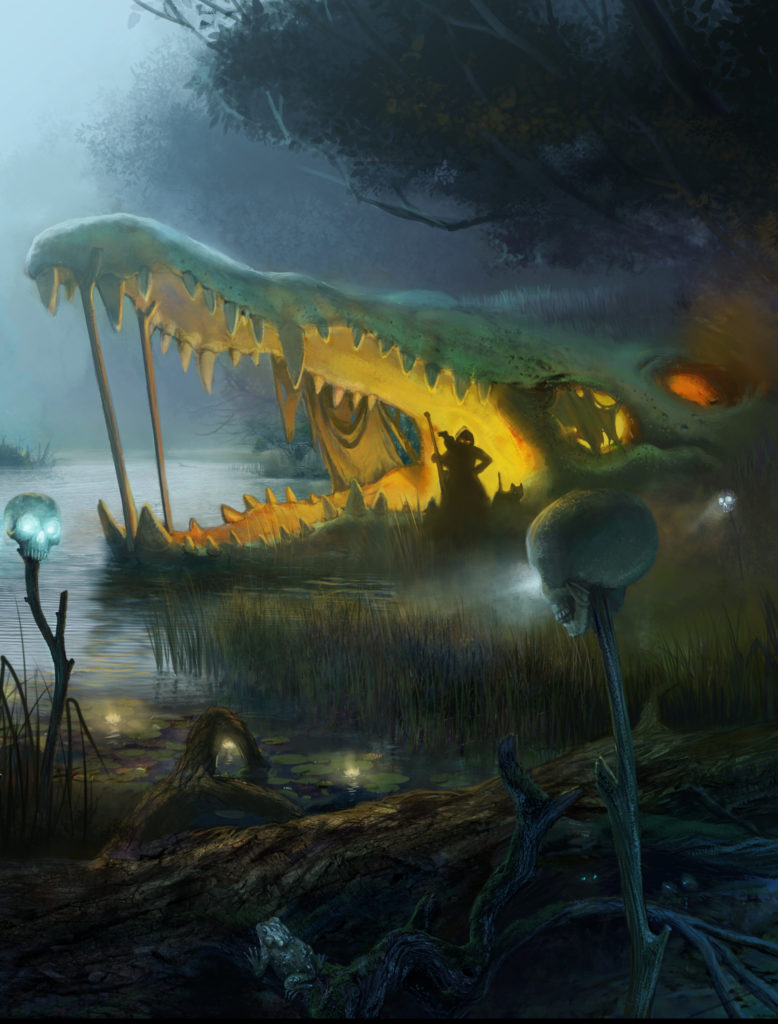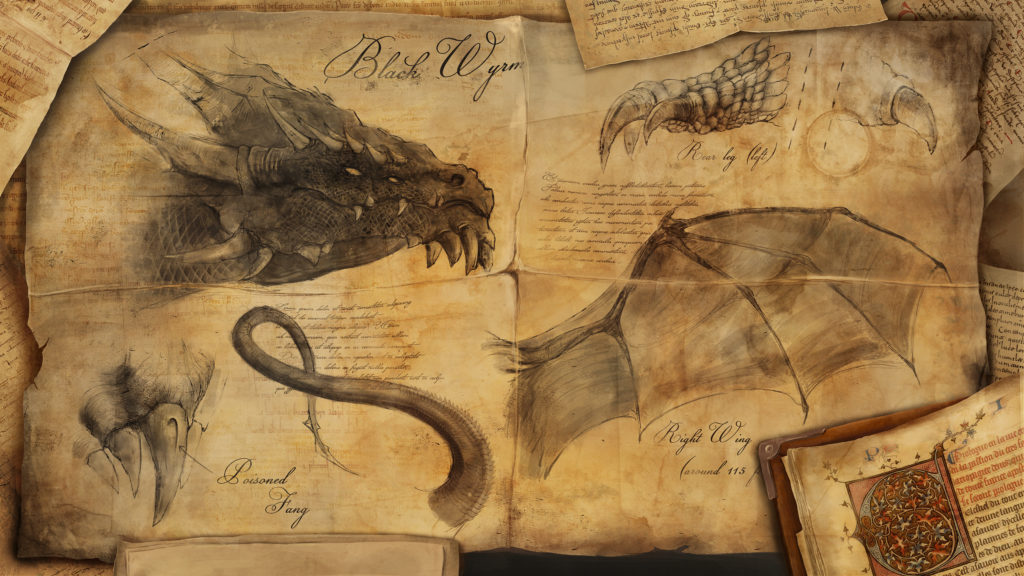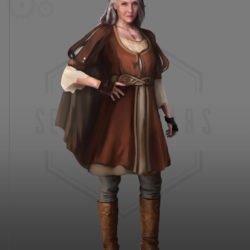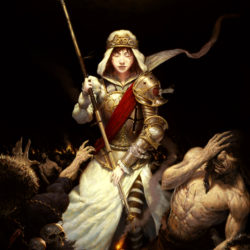Dear gamers,
Our team of writers, lead by Erik Scott de Bie, is making good progress and we have a few chapters ready for review.
Here are the first pages of the first chapter on the History of Ceres, the arrival of the Vareene and the advent of Humanity, written by Erik.
Obviously, this is still subject to change.
We hope you like it!
Tribes
In the First Age, before recorded history, life evolved through various stages from the primordial ooze of a dimly understood age. Untold ages saw the rise of mighty beasts of feather, scale, and claw, and the weaker creatures who emerged alongside them had to content themselves with the scraps of their hunts. In time, however, as the climate changed and became better suited to accommodate smaller forms of life, humanoids began to appear, consisting of three distinct species, who constantly warred among themselves for dominance.
Known for their great intelligence and beauty, the fae created the first fairy circles and the first bow; they ruled over the peaceful plains and deep forests of the world. Mythology looks upon them as impossibly elegant and graceful—immortal beings naturally superior in every way to their more mundane kin—and most tales of ancient lore feature fae creatures in positions of authority or as tricksters. The fae were notoriously stringent with bargains, typically outwitting all but the cleverest heroes, and always hewed strictly to the letter of their words, if not the spirit thereof. The fae were also notoriously atheistic, refusing to make up tales of supernatural beings that had created their world.
The dweor, on the other hand, took glory in their great wisdom and skill with stone; they claimed the tall mountains and wind-swept hills as their homes. Theirs is a tale of industry and labor, of wise but hard choices in the deep darkness below the ground. They tended to take a very careful, studied outlook on any decision. Mythology looks back upon the dweor as hardworking, determined, and plucky. In tales, a dweor is typically cast as the hero, albeit usually a reluctant one. They tended to practice esoteric philosophies and follow religions that were atheistic but strictly codified in terms of moral and ethical standards.
That left the turgid swamps and broken badlands to the orok, a people of great strength and bravery, constantly warring amongst themselves and against the beasts of Ceres. Indirectly, it was through their blood and sacrifice that the other humanoid peoples persisted through the ages, though the myths rarely credit them this glory. In most tales, the orok are presented as brutish and stupid, only a little elevated above the animals they fought against. Most myths refer to the orok as, if not the actual antagonist, at least as a lesser or inconvenient companion to a fae or dweor hero. It is little wonder, then, that the orok grew to resent the other peoples of Ceres, out of both jealousy for their favored status and contempt for their weakness. The orok were a superstitious people and followed animistic religious practices.
The three built great empires in the early age of Ceres, the ruins of which can be seen to this day. Ancient fairy circles loom out of a deep forest, delvers find forbidden halls buried beneath the mountains, and tall barrow mounds mark the sites of ancient battles.
None of these primitive people persist to this day. Had they been left to their own devices, they might have wiped one another out in an endless cycle of warfare, and likely the orok would have emerged victorious in bloody fashion. But something happened then, that would change the course of history forever: the coming of the Vareene.

Arrival
In what would come to be known as the Second Age, a great calamity descended from the skies.
Unbeknownst to either the people of Ceres or their coming descendants, a great battle was being waged amongst the stars. The interstellar empire of the Vareene waged a brutal war against a galactic infestation known only as the Congregation. These humanoid aliens sent their last weapon–a powerful artifact called the Catalyst–rocketing across the galaxy to their outpost on the primitive planet of Ceres, where the Congregation would never think to look for it.
The Vareene were not newcomers to Ceres. They had first established small outposts there a century earlier, in order that they might study the planet and its indigenous life, and potentially harvest it for resources. They remained connected to their greater empire by way of galactic space-time warping portals called voidgates. The Catalyst was too delicate to be brought to the planet by means of one of these gates, and instead it arrived by means of one of the Vareene’s spacecraft.
The plan went awry, however, and the ship was damaged in its escape; what was meant to be a safe and subtle landing on Ceres turned into a terrible crash that damaged the ship beyond repair. This is the source of the great crater at the center of Ceres that would come to be known as the Maelstrom, where leaking magical radiation has caused a permanent storm to rage uncontrolled within its depths.
The Vareene stationed on Ceres managed to recover the Catalyst and store it away in a secret, safe location far from the Maelstrom, so that they might continue with the plan. They erected an interference shield around the planet that scrambled sensor and communications technology and blocked detection from orbit, and closed all the voidgates but one, leaving it as their last link with the empire. And thus they waited to be called upon either to return the Catalyst that it might be used against the Congregation or else for the war to run its course, that they might return to a wounded but surviving Vareene Empire.
Alas, such was not fated to pass. The galactic empire of the Vareene fell, and no further communication came to the outpost, save that the last voidgate—to the Vareene home world—went inert from the other side. They lacked the technology to leave Ceres and investigate, nor the will to do so. For all the local Vareene knew, they were the last survivors of their entire species.
Eventually, the survivors of the Vareene integrated with the native peoples of the planet. The Vareene themselves rarely bred with each other: during the Diaspora of their galactic empire, fertility rates had plummeted, and the concept of producing offspring drew many to the surrounding world. There, their omnigenetics made them able to conceive viable offspring with each of the three distinctly different humanoid species of Ceres, who were naturally infertile with one another.
Regardless of which branch their ancestry climbs, children born to this day may inherit genetic markers that link them to the ancient technology of the Vareene, which eventually became known as magic. Over centuries and then millennia, the Vareene ceased to be a distinct culture, and in time their origins and purpose became the stuff of myth and legend.
The truth was forgotten, but the power of the Vareene lingered in those descended from those original extraterrestrial visitors, including the key to unlocking the mythical Catalyst–which the folk of Ceres will need if their civilization is to survive.
Bloodlines
Unlike most planets in the galaxy, whereupon a singular or perhaps two species emerge as dominant after having crushed all the others, the influx of Vareene blood into the populations of Ceres gave rise to a new era of cooperation at best, or a stalemate of equal power at worst. The Vareene bloodline beats within all the most powerful peoples of Ceres, and access to their technology—also called magic—works as a kind of equalizer to permit such a balance of power.
To all of these disparate peoples, the Vareene brought their ideas of civilization, organization, and most importantly, technology to varying degrees. Most of the tech they had brought from their home world ceased to function when cut off from the greater empire or broke down thereafter, but the Vareene could teach various concepts and accelerate their development to a particular phase.
The Origin of Ancestries
The Vareene had a unique sort of genetic makeup that made them naturally fertile with practically any humanoid creature, and their genes led to the rise of scores of new peoples and ancestries:
- Science-minded Vareene often bred with the fae (producing elves, sylvan gnomes, and other sylvan and faerie creatures) taught them secrets of accessing their technology and using the power of their genes as magic. Their exposure to the magical radiation of Vareene technology buried in the wilder places of the world blessed them with long-life and a propensity for the magical arts.
- Mechanical Vareene were drawn to the dweor (giving birth to dwarves, rock gnomes, halflings, and other stout-hearted peoples), to whom they taught secrets of engineering and mechanics. These descendants of the Vareene tend to invent their own technology and disdain the use of that which they don’t fully understand, such as what modern folk call “magic.”
- Vareene who felt powerless and enraged at the downfall of their empire often turned their back on the civilized ways of their people and integrated amongst the orok, drawn to their lust for battle and bringing a keen insight into warfare to their descendants (orcs, goblins, and reptilian humanoids trace their heritage back to such unions). These children bred quickly and true, overwhelming the lowlands with hordes of Vareene-blessed warriors, but quick generational turnover meant that much of the original Vareene heritage disappeared over a relatively short time.
Monsters of Ceres
Not all the inhabitants of Ceres are humanoid beings. Powerful beasts have always walked the land, and under the influence of leaking Vareene technology (called “magic” by the relatively primitive people of the world), they evolved to become strange and fearsome. Dragons fill the tales of myth and legend, as do chimeras, hydras, and countless other nightmare creatures. These beasts are the subject of the Bestiary.

The Disappearance of the Forebears
Over time, though the Vareene and the original three masters of Ceres persisted for generations (centuries, in the case of the fae), their descendants eventually superseded them and they vanished from history. By the end of the Second Age, which lasted some four or five millennia, the original peoples of Ceres had all but vanished.
In part, this came about due to a correlation between inherited Vareene genetics and improved fecundity, but the influx of Vareene genetics strengthened the peoples of Ceres in many other significant ways. The hybrid children of these disparate peoples tended to live longer to reproduce more often; for instance, elves lived longer than fae, and dwarves outlived their dweor forebears. Orcs were naturally stronger and more robust than orok, leading to their emergence as the dominant force among their people.
It is still theoretically possible to come across a full-blooded Vareene or a member of one of the three forebear folk, but this would require powerful alien technology or a magical explanation.
Gods from Beyond the Stars
The impact that the Vareene’s advent had upon Ceres cannot be overstated, not just in terms of the evolution of the peoples of the world, but also in its effects upon Ceres itself. It essentially short-circuited their natural evolutionary cycle and forever altered the flow of their world’s destiny.
Other than their name and that they came from the skies, little is known for certain of the Vareene, and most of the truth that has endured the ages is steeped in myth and legend. Some claim they were humanoid men and women, just like most of the folk in Ceres, while others believe them to have transcended the bounds of physical form and gender. Most agree they were divine in some way, and far above mortals.
Typically, when folk speak of the Vareene, they use the term “Them” and “Their,” rather than give them something as anthropomorphic as a gender.
The Advent of Humanity
The descendants of the Vareene were not so very different from their indigenous forebears. Elves and their sylvan cousins continued to keep to the forests, though now they practiced magic in its defense. Dwarves and halflings continued to burrow deep into mountains and hills in search of great treasures, though now they sought to fuel their machines. Orcs and goblins were even better suited to battle than their ancestors, and took to it with relish.
Eventually, these three general factions would have destroyed one another, if not for the very same mechanism that had given birth to them from the Vareene: interbreeding. While the fae, dweor, and orok had been too genetically distinct to produce offspring, their descendants were often fertile with one another, due to the Vareene’s genetic makeup. Millennia of this process gave rise to an entirely new species on Ceres: humanity.
Humans are genetic hybrids of various ancestries, heir to none of the strengths or weaknesses of their forebears, but also perfectly capable of adapting to almost any situation. Versatility if their defining trait, as well as a general baseline neutrality with most of the other people of Ceres. They are extremely fertile, live a moderate life, and are capable of conquering most challenges set before them.
Biologically, humans could result from a union between people of various ancestries, such as an elf and a dwarf, an elf and an orc, etc, and humans tend to produce more humans regardless of partner (the most common exceptions being half-elves and half-orcs, because both of those ancestries often breed true). Consequently, many orcs, goblins, and other descendants of the orok have a slight antipathy toward humans, who they typically see as a bastardized, weaker version of themselves, but humans are generally able to prove them wrong in most instances.
Once humanity emerged as a force in the world, Ceres reached the peak of its development, culturally, developmentally, and genetically. Thus began the Third Age.
Humans were a stabilizing force that kept the other descendants of the Vareene from lashing out at one another in their natural drive to destroy one another. Of course, conflict over resources and politics still occurs, but on the societal level, there is no longer any concept of genocidal war or an eternal struggle between different sorts of folk.
By the present year of 1500 VY, humans have risen to control and rule many of the kingdoms of Ceres, and they are widely considered the dominant people of the world.

The Shadowed
Something very insidious and frightening has happened to many folk over the course of history. Due to a genetic anomaly, certain children born to any number of parents may be born “wrong.” They look much like a human but might have pupil-less jet-black eyes, an unusual number of digits (usually three or six fingers on either or both hands), or even more overtly unsettling features like horns, a tail, or a forked tongue. Known most commonly a “The Shadowed” but sometimes also as “devilborn” or “fiendlings,” such folk have abilities unlike those of their nominal ancestry and often manifest significant magical talent. While not inherently evil or malevolent, such folk often find themselves isolated from society and driven to crime or shady alliances with less than upstanding figures. The most notorious instance of a Shadowed is Kurse the Harbinger, the ruler of the Maelstrom.
Ages of Ceres and the Varan Year calendar
The First Age of Ceres is known as the Age of Myth, before the coming of the Vareene. It lasted many thousands of years and culminated in the Calamity from the Skies.
The Second Age of Ceres, also known as the Age of Rebirth, lasted some 4,000-5,000 years, during which the Vareene bred with the existing peoples of the world to produce the folk we know today.
Most historians date the beginning of the Third Age, the Age of Kings, measured by the Varan Year calendar, to when humans erected the great throne of Astaeria. The present year is 1500 VY.
The folk of the Maelstrom follow the same calendar, but they mark the beginning of the Third Age as the founding of their own country, after their exile from Astaeria.



One comment
Love this. I would make one comment, Erik, “infestation” is a trigger word for some people. Otherwise I’m rubbing my hands together waiting for more. I love the alligator/crocodile dwelling illustration!